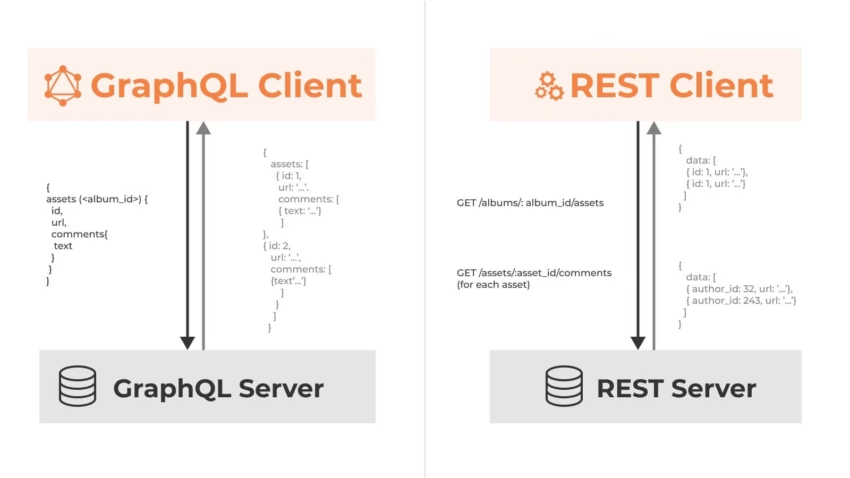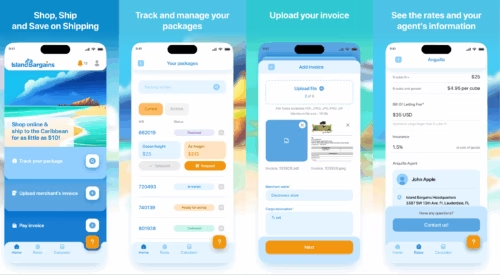
REST vs GraphQL for API development
Are you looking for the best way to develop APIs for your digital product? You might be wondering whether to use GraphQL vs REST for API development. Both GraphQL and REST API development have their advantages. We explain their core differences in this post so that you can take an informed decision.
Key characteristics of REST (Representational State Transfer) APIs
REST (Representational State Transfer) is a software architectural style. The key characteristics of REST APIs are as follows:

Get a complimentary discovery call and a free ballpark estimate for your project
Trusted by 100x of startups and companies like
- APIs built using this architectural concept have a uniform interface.
- You can achieve scalability when developing web services using the REST architectural style.
- You can assign names to resources and access multiple resources using the names.
- You can send or receive data using standard REST API requests.
- Backend developers can map database resources to specific endpoints.
- One can store frequently used data in the memory.
- You can serve RESTful APIs using multiple servers.
Pros and cons of REST APIs
REST APIs offer the following advantages:
- You can scale the software development process using REST APIs.
- REST APIs help you to scale your software application.
- RESTful API development is the de-facto standard. Many developers know it, therefore, you can find skilled developers easily.
- You can use RESTful APIs in different types of projects. They work on multiple platforms. The REST standard supports all key technologies and programming languages.
- Many tools exist for developing, documenting, and testing RESTful APIs. You can develop and manage RESTful APIs easily.
- The flexible nature RESTful APIs makes it easy for you to support specific business requirements.
- RESTful APIs conform to the HTTP specs. Hitting endpoints is easy, therefore, clients don’t need the routing information.
RESTful APIs have some limitations. These are as follows:
- You need to make multiple API calls to retrieve data from multiple endpoints.
- REST APIs don’t maintain states of earlier interactions between the server and clients.
- With REST APIs, clients can get data by hitting endpoints that have fixed data structures. What if a single endpoint doesn’t contain some of the data elements that you need? You need to make multiple API calls. This requires multiple round trips between the client and server. This challenge is called “under-fetching”.
- What if your exact data requirements include only a limited number of data elements? You can only download data from a fixed data structure in the corresponding endpoint. This challenge is known as “over-fetching”.
- REST requests don’t allow you to manipulate nested resources.
- RESTful APIs don’t offer adequate data-searching facilities.
- The REST API standard doesn’t support query validation.
Key characteristics of GraphQL APIs
Meta (erstwhile Facebook) developed GraphQL. It’s a query language as well as an application layer server-side technology. GraphQL is becoming quite popular for API development. Meta open-sourced GraphQL in 2015.
The key characteristics of GraphQL are as follows:
- It’s a declarative language.
- You can use GraphQL with any database, programming language, and operating system. GraphQL is not the same as SQL.
- GraphQL defines how a client application can request data residing on a database in a remote server. The client-side application doesn’t need to depend on the server-side application to define a query.
- GraphQL APIs allow client applications to use a single endpoint.
- In GraphQL, a schema defines how client applications can retrieve or update data. A schema specifies and GraphQL APIs can do. Furthermore, a GraphQL schema specifies what the APIs can’t do. There’s a GraphQL Schema Definition Language (SDL).
- GraphQL is a statically typed language.
- It can return JSON responses.
Pros and cons GraphQL APIs
GraphQL offers several advantages, and it has certain disadvantages.
The advantages of GraphQL
You get the following advantages:
Hire expert developers for your next project
1,200 top developers
us since 2016
- GraphQL is a declarative language and not an imperative one. Developers can understand it easily.
- Since GraphQL is strongly typed, you can avoid a few common programming errors.
- You can define the GraphQL schema with the relationships defined based on your requirements.
- The GraphQL architecture makes it easy to deal with multiple databases.
- You can easily create GraphQL queries, and others can understand them easily.
- The client-side application can define a GraphQL query to specify the data required. A GraphQL request doesn’t need to download the complete data set with unnecessary data elements. A single query can return all the data required. With one request, you can prevent over-fetching and under-fetching.
- You don’t need to create specific endpoints for specific views. The client-side application can define the data-fetching requirements via GraphQL queries. Therefore, your front end can change according to your requirements. Front-end teams don’t need to wait for the API endpoints to change. Front-end and back-end teams can work independently, which expedites the development.
- GraphQL automatically synchronizes the API documentation when the API is changed.
The disadvantages of GraphQL
The disadvantages are as follows:
- Security implications: Expert hackers can take advantage of GraphQL query capabilities. They can submit a very expensive nested query. This can overload a database and server. Without sufficient security measures, GraphQL servers can be vulnerable to DDoS (distributed denial of service) attacks.
- A lack of HTTP caching: GraphQL APIs use a single endpoint. They don’t use HTTP caching, therefore, they can’t store the contents of requests.
- Error reporting issues: GraphQL error messages aren’t informative. This makes reporting and handling errors harder.
- Steep learning curve: GraphQL is relatively new. For developers familiar with the REST standard, there’s a steep learning curve to picking up GraphQL. You need to learn the GraphQL Schema Definition Language.
- Performance issues: Developers have noticed a performance degradation for complex queries.
- Not suitable for simple apps: Using GraphQL query and schema can be complex for simple applications.
Differences between GraphQL vs REST APIs
The differences between REST and GraphQL APIs are as follows:
- REST is a well-known architectural style that’s also popular for API development. On the other hand, GraphQL is a query language for server-side development.
- GraphQL is client-driven, whereas REST is server-driven.
- You can arrange REST APIs in the form of endpoints. On the other hand, you can arrange GraphQL in the form of a schema.
- REST is more established than GraphQL for API development. More developers know about RESTful APIs and GraphQL APIs.
- You often have to design API endpoints in sync with views when you develop RESTful APIs. You don’t need to do that with GraphQL. Also, you can create GraphQL queries quickly. Software development is faster with GraphQL than REST.
- GraphQL APIs use a single endpoint. However, REST APIs use multiple endpoints.
- REST APIs fetch data based on what’s available in an API endpoint. This can cause over-fetching and under-fetching. However, GraphQL queries can fetch the exact data needed by a client-side application. They eliminate over-fetching and under-fetching. GraphQL APIs can offer better performance than RESTful APIs.
- GraphQL has a steeper learning curve than REST.
- GraphQL supports query validation, however, REST APIs don’t allow that.
- You can handle and report errors easily with REST APIs. GraphQL APIs don’t offer meaningful error messages, which makes error handling harder.
- Developers have come up with many ways to secure RESTful APIs. However, GraphQL APIs can have security vulnerabilities.
GraphQL-REST similarities
Considerable similarities exist between REST and GraphQL APIs too. You can use both GraphQL and REST APIs in one project. Backend teams can also transition from one to the other.
The similarities between GraphQL and REST APIs are as follows:
- You can use an HTTP “GET” request with either of them.
- Both GraphQL and RESTful API calls can return JSON data.
- You can specify IDs for fetch-related resources for both of them.
- REST endpoints can call functions on the server. GraphQL fields can do that as well.
- Both of these API development standards have entry points into the data.
- REST and GraphQL can distinguish between API calls for reading and writing data.
When to use GraphQL vs REST?
GraphQL helps you to get exactly the data you need with a single API call. This can help when you develop mobile apps. API calls meeting your exact data needs make the mobile app fast. Consider using GraphQL if you are developing a mobile app with stringent performance requirements.
When describing the limitations of GraphQL, we talked about the lack of HTTP caching. We also alluded to security implications and error reporting issues. Use RESTful APIs if you want HTTP caching, error reporting, and better security.
Hire expert developers for your next project
Want to hire expert developers to build GraphQL or REST APIs? Contact DevTeam.Space.
FAQs
Meta, Instagram, PayPal, Shopify, Twitter, Pinterest, The New York Times, Starbucks, Airbnb, Serverless, Braintree, Coursera, Drift, Credit Karma, GetNinjas, GitHub, Intuit, Fairfax Media, Magento, NBC, Rakuten, and Stackshare, are some of the leading companies that use GraphQL.
Your choice of SQL or NoSQL database doesn’t depend on whether you create REST or GraphQL API. You can choose a database to cater to your specific requirements.
DevTeam.Space developers have experience in both REST and GraphQL API development. You choose GraphQL or REST based on your project requirements, and we can support you.


